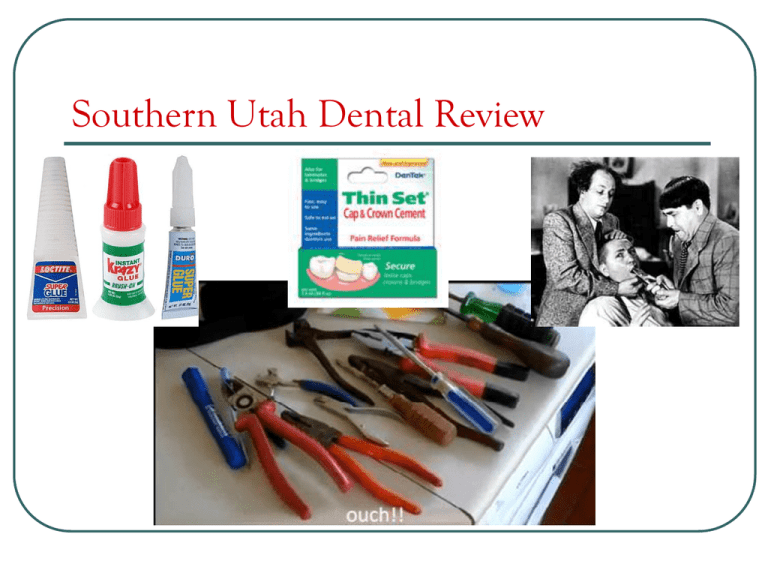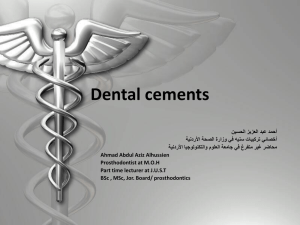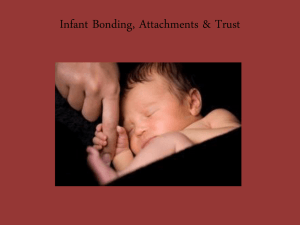File
advertisement

Southern Utah Dental Review Anesthetics Carbide Burs ¼, ½, 2, 4, 6, 8 330 (Pear) 34 169 245 556/557 702/703 1557 Diamond Burs Rounded or Flat Tapered or Straight 379 801 Can also do a One-Time Use Diamond from Midwest Buy 4 (25-packs) at $39.29 each and get 1 free Standard Burs can average $26.99 per 5-pack Cements and Liners Dycal (Dentsply) Fuji Liner (GC America) Vitrebond Plus (3M ESPE) Do I Cement or Bond and With What? Bonding to Ceramic Macromechanical- no sharp edges or surfaces (promotes cracks). Create retentive preparations rather than alter the inside of the restoration. Micromechanical- acid etching and sand blasting. Acid etching with HydroFluoric acid works well for silica based materials because it will etch glass. Phosphoric acid does nothing to any surfaces except enamel and dentin. However, acid etching won’t touch alumina oxide and zirconia cores and may cause cracking. Sandblasting works best for both. Chemical- only with silane and only if silica is present. Use HF to etch silica-based ceramics. Cement Types Luting cements- cements that achieve retention by filling in the gaps between the tooth and the restoration. Adhesion is at best a surface phenomenon of wetting and micro-mechanical interlocking. Bonding cements- stronger than luting cements so “gap filling” offers greater retention. Bonding to tooth structure through the smear layer or into dentinal tubules is more than just a surface phenomenon. Bonding to restorations can be achieved through the use of primers which allow for the chemical adhesion to inorganic fillers, or metal oxides. Luting Cements Used almost exclusively with metal based restorations. Self curing, with generally two components (liquid/powder or paste/paste) for mixing. Four classes: zinc phosphate; polycarboxylate; conventional glass ionomer; resin-modified glass ionomer (marginal Fl release). Of these classes, only conventional glass ionomer and RMGI cements have true indications in modern dentistry. Their indications are limited to metal; metal-based; or core strengthened, glass-free ceramic restorations with retentive preparations. Examples: FujiCem, RelyX Luting, Ketac Cem Luting Cements Paste/paste system Easy mixing, radiopaque, 3min. working time Low film thickness (10 microns ). Do not use a dentin conditioner (removes smear layer). Fluoride release, low solubility Bonding Cement Composite resin cements: are modified composite resin materials with high adhesion, low solubility, and good esthetics. Like any direct composite materials, this class of cements must be used with a bonding system. There are Three subtypes: total-etch system, selfetching system, self-adhesive systems. Composite Resin Cements Total-etch system- most systems are dual cured or light cured. The steps are as similar and diverse as that for direct composite restorations. Examples: Variolink II, Calibra, Duolink, RelyX Veneer cement. In general, any of these systems are moisture intolerant. Self-etching systems- Typically a dual cured, two part system where the acid etching and bonding steps are replaced with a self-etching primer mixed and activated with a bonding agent. The manufacturer’s instructions usually require PhD in interpretive science to decipher. Examples: Panavia F Composite Resin Cements Self-adhesive cements- 3M-RelyX UniCem is the #1 selling cement in the US market. It is a capsule dispensed dual cured cement that eliminates separate etching and bonding steps. It is uniquely moisture tolerant, and has a low risk of post- operative sensitivity. It has a broad range of applications and a simplified technique. Kerr MaxCem. Resin Cements – RelyX Unicem 2 and RelyX Choosing The Right Cement The determination of the cement type begins with the clinical situation not vice versa. This is determined in the treatment planning stage. The key factors that determine restoration and cement type are: esthetic demands, ability to maintain a dry field, occlusal forces, remaining tooth structure, prep design (retentive or nonretentive), and margin location. In general, weak restorations must be adhesively bonded with strong cements. Ceramic restorations require either micro-etching or acid-etching of the undersurface and silane coating to achieve bonding with resin cements; this is not achievable with luting cements. Other Types of Cements PolyCarboxylate – •Durelon (3M ESPE) Glass Ionomer •Ketac Cem (3M ESPE) •Fuji I (GC America) RMGI •RelyX Luting and Luting Plus (3M ESPE) •Fuji Cem and Fuji Cem 2 (GC America) Other Types of Cements Bonded Resin Cement • RelyX Unicem Aplicap * •Dual Cure and Self-Adhesive – NOT for Veneers • RelyX Unicem 2 Self-Adhesive (3M ESPE) * •Claims no need for etching, priming or bonding of tooth • RelyX Veneer (3M ESPE) •Light Cure only – all types of colors to choose from • Variolink Veneer (Ivoclar) * •For Veneers, Inlays and Onlays • NX3 (Kerr) •Light-cure and Dual-cure available in 5 shades • MaxCem Elite (Kerr) •Single Step for all restorations • MultiLink (Ivoclar) • Calibra (Dentsply) Cement Recommendations Composite Crowns, Inlays, Onlays Strengthened core Crowns, bridges Alumina/Zirconia Cement PFM/Metal Inlays/Onlays Glass Ionomer X X RMGI X X Bonded Composite Resin X X X Feldspath or Pressed ceramic Crowns, Anterior Veneers E-Max - Lithium Discilicate X X X Temporary Cement Premier Implant Cement (Premier) Integrity TempGrip (Dentsply) TempBond (Kerr) •Resin based design for security and able to retrieve •Zinc Oxide, Non-Eugenol •Clear version claims to have Triclosan (anti- bacterial to prevent gingivitis but may inhibit muscle contraction – FDA is checking on it) Desensitizers Gluma (Heraeus) MicroPrime (Danville) •Comes in Liquid Bottle, Single Use and Gel •Has the old B version and now G version that is comparable to Gluma at a much lower price •Prestige Dental has it for $50.95 / Gluma is $135.99 in the Benco Catalog Differences Between Self and Total Etch Enamel acid-etching involves demineralizing portions of hydroxyapatite crystals to develop a porous surface for micro-mechanical bonding. Today, acid-etching is performed on dentin, and with a total-etch (TE) or self-etch (SE) technique. Total Etch - In the TE technique, the outer layer of dentin is decalcified, removing the smear layer and opening the underlying dentin tubules. This exposes collagen fibers that are then infiltrated with a primer, followed by the application of a resin adhesive. Primer and adhesive are applied simultaneously in many systems. In this procedure, it is critical that you completely seal dentin tubules to avoid bacterial invasion and/or sensitivity. Generally this technique is used for larger direct restorations and indirect restorations. Self Etch - Rather than removing the smear layer, the SE approach involves the application of an acidic primer that will promote micro-mechanical bonding of the adhesive to the smear layer and the underlying dentin. This technique minimizes the potential for postoperative sensitivity by preventing the collapse of the collagen fibers that can occur after conditioning and drying in the TE process. The SE technique has less clinical history, but appears to be best in less invasive procedures such as shallow Class I or Class II restorations. Primers and Bonding OptiBond (Kerr) – Total-etch XP Bond (Dentsply) – Universal Total-etch “(1 bottle/1 coat)” ScotchBond Universal (3M ESPE) – Total or Self-etch • Claims to bond to metal and Zirconia surfaces Adper Single Bond Plus (3M ESPE) – Total Etch iBond (Heraeus) – Has both Total and Self-etch products • Claims to Desensitize as well with the Self-Etch Peak Universal (Ultradent) – Works with both Self and Total-etch techniques, • Also contains Chlorhexidine for added bond longevity and strength BondForce (Tokuyama) – Self-etching, Fluoride releasing Clearfil SE (Kurary) * - Self-etching primer and bonding agent Clearfil S3 (Kurary) – Self-etch, one-step, fluoride releasing All-Bond ACE SE – Self Etch Brush N’ Bond (Parkell) – Self-etching but seems to be more of a sealer Universal Composite Estelite Omega (Tokuyama) – Spherically filled supra-nano (82% filler) Estelite Sigma Quick (Tokuyama) –“Radical Amplified Photopolymerization Technology” Filtek Supreme Ultra (3M ESPE) * - Nanotech provides retention of a microfill and the strength of a modern hybrid GrandioSO (Voco) Vit-L-Escence (Ultradent) Tetric Evoceram (Ivoclar) Heliomolar (Ivoclar) Venus Diamond (Heraeus) Esthet-X HD (Dentsply) N’Durance (Septodont) Premise (Kerr) Herculite Ultra (Kerr) SonicFill (Kerr) – $818.91 on average for handpiece / Up to 5 mm then cure Flowable Composite Filtek Supreme (3M ESPE) Starflow (Danville) – Claims to have highest compressive strength Surefill SDR (Dentsply) * - Up to 4 mm, 15 of .25 g. for $70-80 (3.75 g.) Venus Bulk (Heraeus)- Up to 4 mm HyperFIL (Parkell) – 22 g. for $65.25, Doesn’t work well with self-etch. Claim to need Brush N’ Bond. Tetric EvoCeram Bulk Fill (Ivoclar) •Also Filtek Bulk Fill – Cure up to 4 mm •Contains Ivocerin – Patented light activator to help full light curing Core Build-Up Materials Clearfil Photocore (Kuraray) – light-cure CorePaste (DenMat) - self-cure Build-It FR (Pentron Clinical) – dual-cure Luxacore Dual (DMG America) – dual-cure FluoroCore 2+ (Dentsply) – dual-cure Crown and Bridge Temp Materials Integrity (Dentsply) * ProTemp Plus (3M ESPE) Structur 2 (Voco) * - Appears to be best price Luxatemp (DMG America) – Star, Plus and Solar PerfecTemp II (DenMat) ExactaTemp (Exacta) MaxiTemp (Henry Schein) Are you Impressed? Alginate Identic (Dux) – •Kromaphase Dust free or Regular Powder (Color change from purple to mix, pink to load and white to seat then 30 sec.) Jeltrate (Dentsply) Chromaclone (Ultradent) * – Walterberry and Bubble gum Flavors, Same color changes as Kromaphase COEflex (GC America) Bite Registration Blu-Bite HP or Clear (Henry Schein) Blu-Mousse (Parkell) * •30 sec. working and 30 sec. set time SuperDent (Darby Dental) Genie (Sultan) MegaBite (DenMat) Vanilla Bite and Chocolate Bite (DenMat – just bought from Philips Discus) •Superfast has 60 sec. setting time in Mint flavor •Spearmint flavor – 55 sec. set time •What else to say, its chocolate flavored!!! Claims 45 set time. Vinyl Polysiloxane Aquasil Ultra (Dentsply) * Exafast NDS (GC America) * Genie (Sultan) * Imprint II Garant (3M ESPE) Precision Plus (Burkhart) FlexiTime (Heraeus) • Has XLV, LV, Monophase, Heavy and Rigid Options • Regular, Monophase and Heavy Options • 90 sec. set even in a wet enviornment • Berry flavored with Extra Light, Light, Regular and Heavy Body • Has an Advanced ThermaSense (ATS) which allows fast setting material with flexible working times. PolyEther Impregum F (3M ESPE) Impregum Soft •Base/Catalyst Mix •Cartridge mix from tip, Easier removal Bleaching Take Home Bleaching Venus White Pro (Heraeus) Opalescence PF (Ultradent) – Melon, Mint, Regular Opalescence Oh! (Ultradent) Zoom NightWhite and Day White (Philips) • 16% - Daytime of 4-6 hours, Nightime 8-10 hours • 22% - Daytime of 60 minutes 1-2 times a day • 10% - 8-10 hours or overnight • 15% - 4-6 hours • 20% - 2-4 hours • 35% - 30 minutes • Same as PF but in individual doses • NightWhite 10%, 16% and 22% are Hydrogen Peroxide 4%, 6%, 8% respectively • DayWhite is 9.5% and 14% (The 14% was named 38% but they changed the name to not have people thinking it was a full 38% HP. It is a mix of HP and Carbamide) In-Office Bleaching Opalescence Boost 40% (Ultradent) Venus White Max 38% (Heraeus) Pola Office 37.5% (SDI North America) LumaWhite Plus 35% (Luma-lite) • 2 – 20 minute applications • Claims to strengthen enamel, decrease sensitivity and prevent caries • Patient kit - $51.99 • 3-4 – 15 minute applications • Contains potassium nitrate to decrease sensitivity • Patient kit - $55.99 • 3 – 8 minute applications • No mixing materials, Contains potassium nitrate, with or without light • Patient kit - $75.99 • 3 – 8 minute applications • Includes “Stay Bright” professional take-home maintenance kit/enhancer • Patient kit - $68.99 In-Office Bleaching Zoom WhiteSpeed BriteSmile Dash • Clinicals show proven 8 shades brighter in 45 minutes • Uses LED light to accelerate the bleaching gel • Similar to WhiteSpeed • In concentrations of 15 or 25% Hydrogen Peroxide • 30% hydrogen peroxide whitening gel. No syringe-to-syringe mixing • Sensitivity management. Includes a syringe of Relief ACP, that combines chemical sensitivity relief (potassium nitrate) and long-term relief with ACP (Amorphous Calcium Phosphate) and fluoride. These are all Philips brands. They also have a Zoom Whitening Pen for maintenance with 5.25% Hydrogen Peroxide. Final Wrap-Up Sample Requests Treatment Videos Discounts/Rebates •How to for Cutting/Temping/Bonding Veneers •Possibility of Starting CE Library








